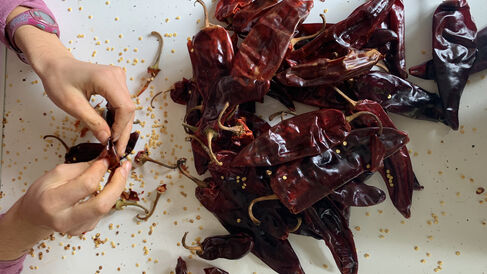
Desvenar: Reimagining Fieldwork by Daniela Sclavo
The second instalment in our project blog, where From Collection to Cultivation members share research insights, snippets, and ideas.
Inés instructed me to wash and desvenar the guajillo chiles for the next day’s mole. The literal translation of desvenar is to devein, stripping out the veins and seeds in the interior of chiles. While I occupied my untrained hands in the endeavour—my skin already stinging from the capsaicin—Inés explained the process to us. Without revealing a single aspect of her famous recipe, she spoke of cuisine and heritage, how she learned from older women in the community and in Mexico City, and from everyday practice. Sitting at her table, going through all the chiles, we also shared a space for mutual recognition, for laughter, for understanding. Desvenar, then, acquired a more wholesome meaning: by tearing out the veins and seeds we were also unravelling, creating, and interlacing stories and experiences.
My project studies the ways subjective elements such as flavour, taste, or identity have shaped different chilli pepper conservation efforts in Mexico from approximately the 1960s until the present day. As such, I consider the perspectives and imaginaries of different social groups—mainly that of plant breeders, ethnobotanists, and local communities—in terms of why it is important to conserve a crop so linked to Mexican diets and identities. One of my main interests, however, relies on giving a space in my narrative to women that have used and practiced culinary traditions for generations, and whose knowledge has been underrepresented and undervalued in explanations about crop conservation science in academia. In this sense, my project underlines the importance of fieldwork in the history of science; some narratives must transcend the premises of the archives. In the case of chile, histories are still alive and ongoing.
Telling some stories, as in the case of Inés and her mole, requires a sense of dedication, of interaction, of connectedness. While formal interviews are adequate for building the oral histories of certain actors, they can be tremendously futile in other contexts. Sometimes, trust and emotion are needed to bond, to empathise, to connect and tell a more compelling and—most importantly—just story. How can I give women’s knowledge on chile and cuisine a fair space if I do not construct it with them? In a way, even if we as historians build individual arguments or theses, we write alongside other’s lives, memories, trajectories: our voice is never just our own.
Cooking with Inés, being received in her house, helping her prepare the chiles, and eat with her while listening to her story made me reflect on how I carry out my research, and on how in particular kinds of histories, we sometimes forget to acknowledge the importance of these interpersonal relations and the impact they can have on us both as professionals and as individuals. By working with conceptualisations of chile, cuisine and food, it even seems impossible to disassociate from a more personal and sensitive frame, as my research touches on what we find on our plates, and on the relations we have with what we eat and where we come from. So, why don't we talk more about emotions and trust when discussing fieldwork? Does it come across as subjective in the process of building a solid argument? That day with Inés, I thought it important to desvenar my own historical methods and conceptualisations—even if it stings a little.
You can find out more about Daniela's research on chiles, conservation, and flavour at her research page here.
